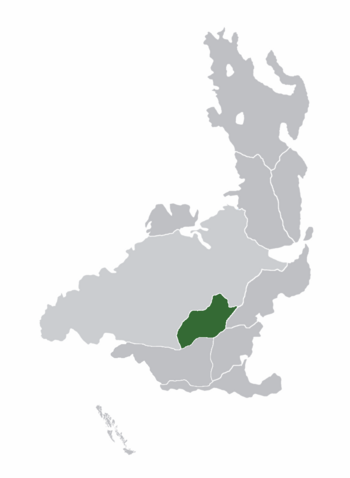Uulgadzar
United Kingdom of Uulgadzar and Rakakraina | |
|---|---|
Motto: Бид хаана байх, бид явах Bid khaana baikh, bid yavakh "Where we stay, we go" | |
Anthem: Уулгазар улсын төрийн дуулал Uulgadzar ulsyn töriin duulal "National Anthem of Uulgadzar" | |
 Location of Uulgadzar in Ostlandet | |
| Capital and largest city | Uulhot |
| Official languages | |
| Ethnic groups (2020) | 67% Uulgadzan 31% Stepadnó 2% Other |
| Religion (2020) | 67.9% Ariunxavč 16.1% Christian 9% Atheist/Agnostic/No religion 7% Other |
| Demonym(s) | Uulgadzan |
| Government | Unitary parliamentary constitutional monarchy |
• Khagan | Yurukhan Khan |
| Guntomor Khasar | |
| Legislature | Jaria |
| Terguun Jaria | |
| Commons Jaria | |
| Formation | |
| 17 May 670 CE | |
| 13 August 1591 | |
| 3 July 1637 | |
| 18 December 1929 | |
| Area | |
• Total | 541,902 sq mi (1,403,520 km2) |
| Population | |
• 2022 estimate | 6,433,030 |
• 2020 census | 6,200,319 |
• Density | 11.44/sq mi (4.4/km2) |
| GDP (nominal) | 2020 estimate |
• Total | ₵82,206,743,452 |
• Per capita | ₵13,258.47 |
| Gini (2020) | 39.8 medium |
| HDI (2020) | high |
| Currency | Uulgadzan tögrög (UUT) |
| Time zone | TMB+11 (UGT) |
| Mains electricity | 120 V-60 Hz |
| Driving side | right |
| Calling code | +77 |
| ISO 3166 code | UU |
| Internet TLD | .uu |
Uulgadzar (Uulgadzan: Уулгазар; Stepadnó: Уулгадзар), officially the United Kingdom of Uulgadzar and Rakakraina (Uulgadzan: Нэгдсэн Вант Уулгазар ба Ракакрина улс; Stepadnó: Карале́ўства Уулгадзар і Ракакраіна) is a land-locked unitary parliamentary constitutional monarchy in Ostlandet. It is bordered by Syntsi to the northwest, Byasa to the northeast, Zloveshchiy to the east, Gjorka to the southeast, and Ajakanistan to the south. Uulgadzar has a land area of 541,902 square miles (1,403,519 km2). Its total population, according to the 2020 census, is 6,200,319, making it one of the least populous countries in the world. Its capital and largest city is Uulhot, with other major urban centers in Shinemori and Darkhan.
The first proto-Uulgadzan people arrived in the area of Uulgadzar around 4000 BCE. Agriculture developed around 1000 BCE in the area of Rakakraina, but generally did not spread to Uulgadzar proper until around 500 CE. The first recorded khanates in Uulgadzar arose around 1000 BCE, with the Uul Khanate and the Hoyd Khanate. These were primarily nomadic tribal groups led by a khan. Uul and Hoyd merged with the Treaty of Uulhot in 670 CE, creating the Union of Uul under Tamachag I, who became the first Khagan. In the 14th century, the Nogan Wars under Nogan I expanded Uulgadzar into the area of modern Byasa. In the late 15th to early 16th centuries, a series of wars with the Gyatso dynasty in northern Byasa weakened Uulgadzar, in addition to the War of the Rock where the Serene Republic of Rigrongseb won independence from Uulgadzar. Throughout the 16th century, a series of wars with the Empire of Baltanla led to a loss of the majority of Uulgadzan holdings and tributaries in Byasa. In 1594, the Uulgadzan Civil War broke out after Mikhail I and IV became Khagan and enacted a series of anti-terguun reforms. The terguun won the war, and Mikhail was forced to sign the 1599 Decree of Rights, which established Uulgadzar and Rakakraina as a united kingdom and the Jaria, the legislative body which had to approve all tax changes. In 1882, Miraslaŭ Khan, the Khagan at the time, refused to summon the Jaria (by this point yearly summons of the Jaria was expected) and so the terguun overthrew Miraslaŭ in the Glorious Revolution in 1883 and installed Ganbaatar II as Khagan. In 1923, a military coup d'état established a fascist military junta under the People's Republic of Uulgadar, and the Khagan fled to Rakhman. In 1980, a democratic-royalist coup re-established royal and democratic rule in Uulgadzar.
Uulgadzar's GDP per capita of ₵13,258 is one of the lowest in the world, but it has been consistently growing since 2010. Its income inequality is one of the highest in the world. The head of government is currently First Commoner Guntomor Khasar, while the head of state is currently Khagan Yurukhan Khan (Yurukhan III).
Contents
Etymology
Uulgadzar (уулгазар) comes from uul (уул) meaning mountain and from gadzar/gazar (газар) meaning ground or land.
History
Geography and Climate
Uulgadzar contains a mix of temperate, semi-arid, and arid climates. In the south and north-west, semi-arid steppe climate dominates, causing hot temperatures with little rain. In the west, the Dogšin Desert has a predominately arid climate, with temperatures rarely, if ever, reaching below freezing, and nearly no rain. It is the most sparsely populated place in Uulgadzar. In the east, a temperate climate exists. It is separated from the semi-arid and arid climates by the Uulgadzar Mountains.


